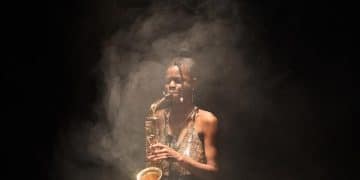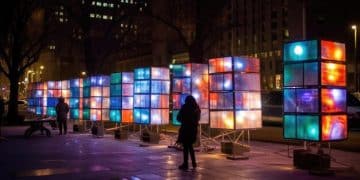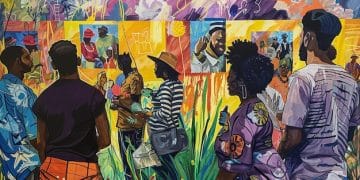Power of Protest Art: 7 Iconic Works That Shaped American History
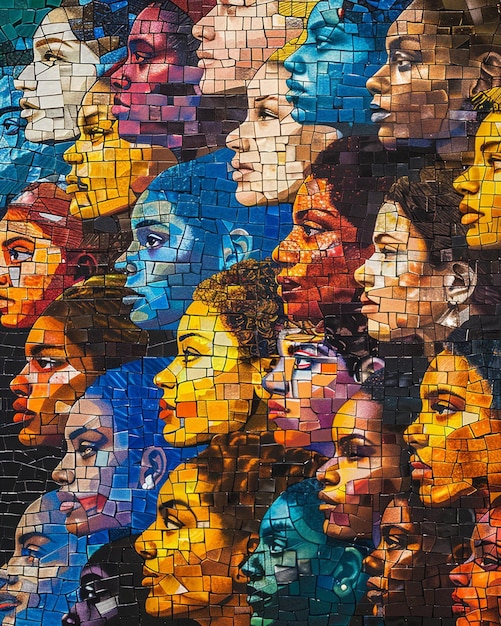
The power of protest art lies in its ability to transcend traditional communication, serving as a powerful visual voice that galvanizes social change and imprints pivotal moments of American history on the collective consciousness, embodying the very essence of public dissent and societal transformation.
From the earliest days of American dissent to contemporary movements, art has consistently served as an undeniable force for change. The Power of Protest Art: Examining 7 Iconic Works That Shaped American History delves into how visual expressions can ignite action, provoke thought, and immortalize the struggles and triumphs of generations. Join us as we explore the indelible mark these seven influential pieces have left on the nation’s trajectory.
The Enduring Legacy of Art as Activism
Protest art, often born from moments of deep societal tension and aspirations for justice, weaves itself into the fabric of American history. It’s a testament to the idea that some messages are best conveyed not through words alone, but through symbols, colors, and forms that resonate on a visceral level.
These works serve as historical markers, capturing the zeitgeist of their era while simultaneously pushing the boundaries of public discourse. They challenge the status quo, champion the marginalized, and offer a visual narrative that complements, or even supersedes, journalistic accounts or political speeches.
Defining Protest Art’s Impact
The impact of protest art is multifaceted. It informs, inspires, and oftentimes incites action. Its power stems from several key attributes:
- Universal Communication: Art transcends language barriers, allowing complex ideas to be understood by diverse audiences.
- Emotional Resonance: Visuals can evoke strong emotions, fostering empathy and shared understanding regarding social injustices.
- Historical Archive: These pieces act as enduring records, preserving the memory of struggles and the hopes for a better future.
- Catalyst for Dialogue: They spark conversations, challenging individuals to confront uncomfortable truths and consider new perspectives.
Ultimately, protest art is a dynamic force, a living response to the unfolding narrative of a nation perpetually striving for its ideals. It underscores the belief that creativity is not merely aesthetic, but a potent tool for social engineering and historical documentation.
“The Scottsboro Boys” by Elizabeth Catlett (1939)
Elizabeth Catlett’s profound linocut series, “The Scottsboro Boys,” stands as a stark and powerful indictment of racial injustice within the American legal system. Created in 1939, this body of work vividly portrays the harrowing experience of nine African American teenagers falsely accused of rape in Alabama in the 1930s, highlighting the systemic racism prevalent during the era.
Catlett, a pioneering African American artist and activist, used her art as a weapon against oppression. Her bold, expressionistic style captured the anguish, fear, and defiant spirit of the accused, making their plight undeniable to viewers. The series served as a visual counter-narrative to the prevailing racist rhetoric and media portrayals of the time, demanding empathy and justice.
Symbolism and Legacy
Each print in “The Scottsboro Boys” series employs powerful symbolism:
- Distorted Figures: Reflecting the dehumanization and suffering caused by the unjust accusations.
- Dark, Heavy Lines: Emphasizing the weight of the legal system and the burden of racial prejudice.
- Confrontational Gaze: Some figures directly challenge the viewer, demanding accountability and action.
This work’s legacy extends beyond its immediate historical context. It became an enduring symbol of the fight for civil rights, laying groundwork for future artistic expressions of resistance. Catlett’s art not only documented history but actively contributed to shaping the consciousness around racial inequality, reminding us of the long struggle for true equality and the role of art in that journey.
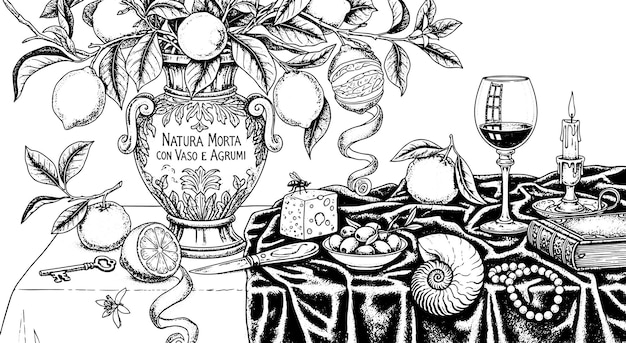
“We the People” Series by Shepard Fairey (2017)
Shepard Fairey, best known for his “Hope” poster for Barack Obama, once again captured the visual pulse of a movement with his “We the People” series. Launched in immediate response to the 2017 presidential inauguration and prominently displayed during the Women’s March, these posters swiftly became ubiquitous symbols of resistance and unity, advocating for diverse American identities and values.
The series features impactful portraits of women from various cultural backgrounds, including a Muslim woman in a hijab, a Latina woman, and an African American woman, each adorned with a patriotic motif and the rallying cry, “We the People.” This direct invocation of the U.S. Constitution’s preamble asserts the fundamental rights and collective power of all citizens, particularly those who felt disenfranchised or threatened by newly enacted policies.
Artistic Approach and Impact
Fairey’s signature blend of street art aesthetics and political messaging contributed to the series’ rapid dissemination and impact:
- Bold Graphics and Limited Color Palette: Ensuring high visibility and immediate recognition.
- Direct and Inclusive Imagery: Representing a broad spectrum of the American population.
- Open Access: The high-resolution files were made freely available online, encouraging widespread printing and distribution, thus amplifying their message.
The “We the People” series not only empowered marchers and activists but also sparked conversations about civic duty, inclusion, and the foundational principles of American democracy. It demonstrated how contemporary art, through digital and street distribution, can quickly mobilize public sentiment and serve as a powerful emblem of collective action in the digital age, solidifying its place as a cornerstone of modern protest art.
“Guernica” by Pablo Picasso (1937) – A Universal Cry
While fundamentally a response to the Spanish Civil War, Pablo Picasso’s monumental painting “Guernica” transcended its specific origins to become a universal symbol of the horrors of war and the suffering inflicted upon innocent civilians. Created in 1937, it powerfully condemns the Nazi bombing of Guernica, a Basque town, making a profound statement against fascism and violence that resonated deeply in America and globally.
Picasso’s Cubist style, with its fractured forms and stark contrasts, perfectly conveyed the chaos, destruction, and brutality of the aerial attack. The painting depicts distorted figures—a screaming horse, a mother cradling her dead child, a soldier’s dismembered arm—all enveloped in a monochromatic palette that intensifies the feeling of despair and anguish.
Its American Resonance
“Guernica” was exhibited extensively in the United States from 1939 to 1981, initially as part of a fundraiser for Spanish Republican refugees and later on long-term loan to the Museum of Modern Art (MoMA) in New York. Its presence in America was pivotal:
- Anti-War Sentiment: It became a powerful visual argument against interventionism and the global rise of fascism before and during WWII.
- Artistic Influence: It inspired American artists to use their craft for political commentary.
- Symbol of Dissent: During later conflicts, particularly the Vietnam War, “Guernica” was frequently cited and referenced as an ultimate expression of anti-war sentiment.
Its enduring presence in the American consciousness underscores the power of a single artwork to shape public opinion and galvanize protest across different historical contexts. “Guernica” serves as a timeless reminder of human cruelty and resilience, making it a critical piece in the discourse of American protest art and its global influences.
The Black Panther Party’s Revolutionary Art (1966-1982)
The art produced by the Black Panther Party (BPP) was inseparable from its revolutionary ethos and political objectives. Emerging in 1966, the BPP utilized a wide range of visual materials—posters, newspapers, pamphlets, and iconic photography—to communicate its message of Black empowerment, self-defense, and liberation. Their art was not merely illustrative; it was a potent tool for propaganda, education, and recruitment.
Emory Douglas, the Minister of Culture for the Black Panther Party, was central to shaping their visual narrative. His bold, graphic illustrations, often featured in the party’s newspaper, “The Black Panther,” depicted armed, defiant Black figures challenging symbols of oppression and advocating for community programs. This vivid imagery stood in stark contrast to mainstream media portrayals of African Americans.
Key Characteristics and Impact
The BPP’s art was characterized by:
- Direct Messaging: Clear, unambiguous calls to action and political statements.
- Strong Iconography: The Panther logo, armed figures, and symbols of racial injustice were instantly recognizable.
- Accessibility: Produced for mass distribution, making it widely available to the Black community and beyond.
This art played a crucial role in mobilizing support for the BPP, fostering solidarity within the Black community, and challenging the narrative of white supremacy. It embodied the spirit of Black pride and resistance, influencing subsequent movements for social justice and firmly establishing art as an integral part of grassroots activism in American history. The BPP’s visual legacy reminds us that art can be a direct instrument of social and political transformation.
“Hope” Poster by Shepard Fairey (2008)
Shepard Fairey’s “Hope” poster for Barack Obama’s 2008 presidential campaign rapidly became one of the most iconic political images of the 21st century. While arguably more campaign art than protest art in its initial conception, its widespread adoption and subsequent transformation into a symbol of collective aspirations and political hope gave it an undeniable protest undertone against the backdrop of war, economic crisis, and political division.
The poster features a stylized, stencil portrait of Barack Obama in red, white, and blue, with the word “HOPE” emblazoned below. Fairey’s design was deliberately stripped-down and accessible, echoing the aesthetics of propaganda posters while simultaneously evoking a sense of grassroots optimism and forward momentum. It capitalized on the public’s desire for change and a new political direction.
Cultural Phenomenon and Influence
The “Hope” poster’s impact was undeniable, reaching far beyond traditional campaign advertising:
- Mass Replicability: Its simple design allowed for easy reproduction and wide dissemination, from stickers to murals.
- Unifying Symbol: It became a visual rallying point for Obama supporters and those yearning for political transformation.
- Artist as Activist: It propelled Shepard Fairey into the global spotlight, cementing his reputation as a significant voice in contemporary political art and demonstrating the power of independent artistic creation in a major political campaign.
By capturing the mood of a nation eager for transformative leadership, “Hope” transcended its initial purpose to become a powerful cultural touchstone. It affirmed art’s capacity to both reflect and shape public sentiment, articulating a collective desire for a better future and demonstrating how visually compelling art can become an emblem of an entire socio-political movement within American society.
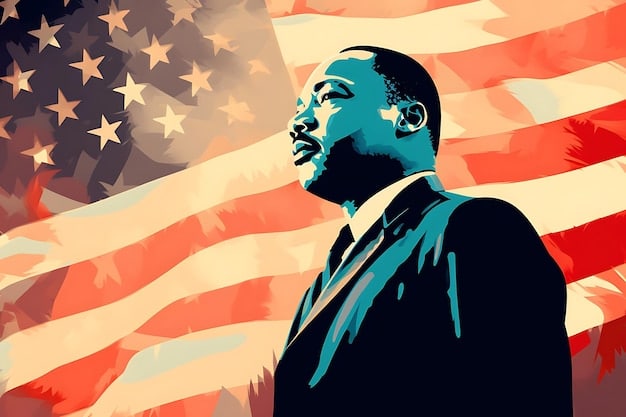
Gran Fury and ACT UP: Art as Direct Action (1987-1995)
During the devastating AIDS epidemic, the activist collective Gran Fury emerged from the heart of ACT UP (AIDS Coalition to Unleash Power), leveraging art as a weapon against government inaction, pharmaceutical greed, and societal prejudice. From 1987 to 1995, their work transformed public spaces and media landscapes, demanding recognition, empathy, and immediate public health action.
Gran Fury’s approach was characterized by its fierce, often confrontational direct action, utilizing bold, text-heavy graphics that mimicked advertising campaigns. Their iconic slogans like “Silence = Death” and “Kissing Doesn’t Kill: Greed and Indifference Do” were plastered across billboards, buses, and public service announcements, forcing a reluctant public and political establishment to confront the scale of the crisis.
Innovative Tactics and Enduring Impact
Their artistic interventions were distinguished by:
- Strategic Use of Public Space: Turning city streets and public transport into canvases for their message.
- Subversion of Commercial Aesthetics: Using Madison Avenue-style graphics to deliver radical political messages.
- Empowerment Through Information: Disseminating critical facts about AIDS transmission and prevention, countering misinformation and stigma.
Gran Fury’s work not only raised awareness but also fundamentally shifted public perception of AIDS from a marginalized issue to a pressing human rights crisis. Their uncompromising and visually potent campaigns forced governments and pharmaceutical companies to respond, ultimately saving countless lives. This collective masterfully demonstrated how art, when coupled with direct action and a clear political agenda, can be a force for monumental social change and a model for future protest movements in American history.
“Fearless Girl” by Kristen Visbal (2017)
Kristen Visbal’s “Fearless Girl” statue, controversially installed in front of the “Charging Bull” sculpture near Wall Street in 2017, quickly became a potent symbol of female empowerment and a challenge to corporate male dominance within the financial industry. Though initially commissioned by State Street Global Advisors as part of a marketing campaign, its resonance with the burgeoning women’s rights movement instantly elevated its status to that of impactful protest art.
The bronze sculpture depicts a young girl, hands on her hips, chin held high, standing defiantly against the aggressive posture of the bull. Her stance embodies courage, resilience, and a bold assertion of female strength in traditionally male-dominated spaces. It served as an immediate visual shorthand for the ongoing fight for gender equality in leadership, pay, and representation.
Symbolism and Controversy
The “Fearless Girl” generated both immense praise and heated debate:
- Empowerment Symbol: It inspired millions, particularly women and girls, as a beacon of strength and determination.
- Corporate Co-option Critiques: Some argued its corporate origins diluted its message, or that it was “feminist-washing.”
- Artistic Debate: The creator of the “Charging Bull” viewed it as an infringement on his artistic message.
Despite the controversies, “Fearless Girl” undoubtedly captured a critical moment in American culture, sparking discussions about gender roles, corporate responsibility, and the representation of power. Its placement in a highly visible financial hub ensured its message was seen and debated, solidifying its position as a powerful, albeit complex, piece of contemporary protest art that continues to shape dialogue on gender equality in the U.S.
| Key Point | Brief Description |
|---|---|
| 🎨 Universal Message | Protest art transcends language, communicating complex social issues globally. |
| ✊ Catalyzing Change | Acts as a powerful catalyst for dialogue and direct action against injustice. |
| 📜 Historical Record | Preserves the memory of struggles and aspirations for future generations. |
| 💡 Inspiring Action | Motivates individuals and groups to participate in social and political movements. |
Frequently Asked Questions About Protest Art
▼
Protest art is a creative expression used to challenge power structures, advocate for social change, or express dissent. It’s crucial in American history because it provides a visual record of societal conflicts and aspirations, offering a unique perspective on moments like the Civil Rights Movement or anti-war protests, often galvanizing public sentiment in ways traditional media cannot.
▼
Protest art reaches its audience through diverse channels, ranging from traditional gallery exhibitions and museum displays to more accessible public spaces. This includes street art, posters, murals, digital art shared online, and performances. Its effectiveness often hinges on widespread distribution and visibility, ensuring its message resonates within the community and beyond.
▼
Yes, protest art can be effective even without immediate, tangible change. Its power often lies in sparking dialogue, raising awareness, fostering empathy, and creating a sense of solidarity among those who share the message. It contributes to a long-term cultural shift that can eventually lead to policy changes or societal transformation, often serving as a historical touchstone for future movements.
▼
While both use visual communication to influence opinion, propaganda often aims to promote a specific political agenda or ideology, typically sanctioned by those in power, and may suppress dissenting views. Protest art, conversely, usually challenges prevailing narratives, criticizes authority, and advocates for marginalized voices, emerging from grassroots movements or individual artists rather than state-sponsored directives.
▼
Yes, legal limitations exist, particularly concerning property rights and public safety. While freedom of speech protects artistic expression in the U.S., engaging in vandalism (e.g., graffiti on private property without permission) or creating art that incites violence or harassment can lead to legal penalties. The context of display—public versus private property—heavily influences its legality.
Conclusion
The journey through these seven iconic works reveals that protest art is far more than mere decoration; it is a raw, dynamic force that mirrors and shapes American history. Each piece, from the solemn indictments of Elizabeth Catlett to the unifying calls of Shepard Fairey and the defiant stance of “Fearless Girl,” stands as a testament to the artist’s role as a commentator, provocateur, and often, a prophet. These artworks transcend their immediate contexts, enduring as powerful reminders of the struggles, aspirations, and continuous evolution of a nation striving for justice and equality. They underscore the invaluable truth that the visual voice can be one of the most potent drivers of change, securing its place as an indispensable element in the American narrative.
